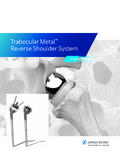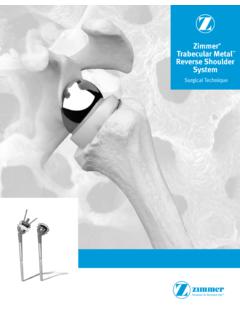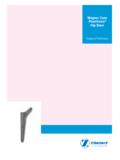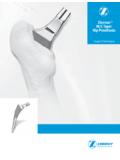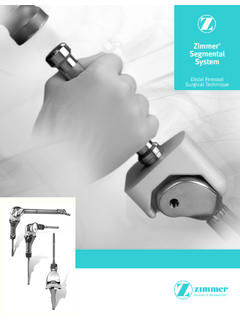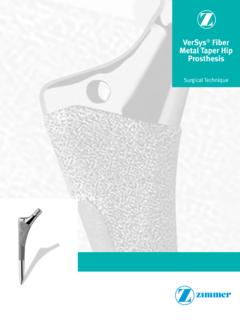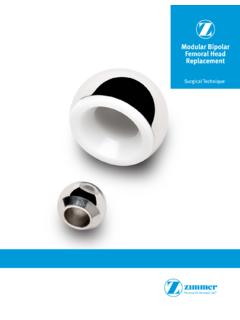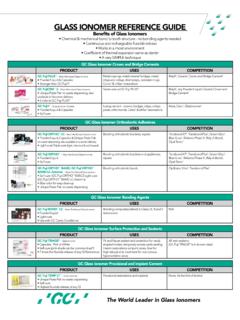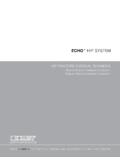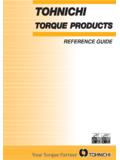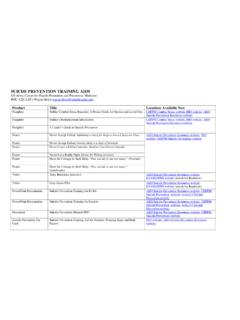Transcription of Zimmer Trilogy IT Acetabular System - Hip | Knee
1 1 Zimmer Trilogy IT Acetabular SystemSurgical Technique2 Zimmer Trilogy IT Acetabular System Surgical TechniqueDevice Description The Trilogy IT Shell is hemispherical in shape with an exterior of commercially pure titanium Fiber Metal Material that is bonded to a Tivanium alloy substrate. The Shell has a snap fit locking groove for acceptance of the Vivacit-E Vitamin E Highly Crosslinked Polyethylene Neutral or Elevated Liners and the Longevity Highly Crosslinked Polyethylene Neutral or Elevated Liners. Twelve scallops, equally spaced in 30 increments, included on the Shell face mate with twelve anti-rotation tabs on the Vivacit-E Vitamin E and Longevity Liners. Indications/Intended Use The System is indicated for primary or revision surgery in skeletally mature individuals for rehabilitating hips damaged as a result of noninflammatory degenerative joint disease (NIDJD) or its composite diagnoses of osteoarthritis, avascular necrosis, protrusio acetabuli, traumatic arthritis, slipped capital epiphysis, fused hip, fracture of the pelvis, and diastrophic variant.
2 The System is intended for use either with or without bone cement in total hip Trilogy IT Acetabular System Surgical TechniqueShell provisional 54mm provisional has a 54mm Acetabular Reamer 54mm Reamer has a 54mm Cup 54mm Trilogy IT Cup has a 54mm The labeled outside diameter ( ) of the Acetabular cup represents the true hemispherical diameter of the Implant. An appropriate undersized reamer must be used to prepare the acetabulum if a press fit condition is desired. The amount of press fit used should be determined at the time of surgery and be based on bone quality. Shell Implants are labeled with the exterior size and a corresponding two letter code ( 56 KK). The matching Liner Implants are identified with the matching letter code and head diameter ( 28 KK, 32 KK, 36 KK, 40 KK).
3 Templating The primary goal of templating is to estimate the size and position of the Acetabular Implant. 45 degrees of abduction and 20 degrees of forward flexion is recommended in most cases. Use of the alignment guides with various patient positions is outlined in later sections of the technique. To increase the accuracy of templating, digital imaging or x-rays with magnification markers should be used. The magnification of the x-rays and the templates should be compared when sizing the should start with the A/P radiograph. (Fig. 1) The component should NOT be more medial than the cortyloid notch and should NOT be against the radiographic tear drop. To avoid vertical cup placement a line drawn along the cup template opening should intersect the obturator foramen.
4 It may be helpful to cross-check the Acetabular component size on the lateral radiograph, which can provide a view of the hemispherical subchondral bone. The largest component that meets these requirements should be selected. However, the final decision on component size should be made during surgery, when all aspects of the acetabulum can be fully 1 AP Templating : Head centers are the same for all liner : This is intended to be used as a surgical planning aid and not as a measuring (Set of 3) 0905-H02 .05ML Printed in USA 2009, 2010 Zimmer , Acetabular SYSTEM20% ENLARGED TEMPLATE 248mm 58mm0mm10mm20mm30mm40mm50mm60mm70mm80mm9 0mm100mm110mm120mm130mm140mm150mm160mm17 0mm180mm190mm200mm210mmTRILOGY IT Acetabular SYSTEM4 Zimmer Trilogy IT Acetabular System Surgical TechniqueSurgical ApproachThe Trilogy IT Cup may be implanted using a variety of standard surgical approaches.
5 Note: While the surgeon s approach may vary, the approach must provide adequate exposure to visualize the entire Acetabular PreparationExcise the Acetabular labrum and remove any large peripheral osteophytes. Excise the ligamentum teres to expose the true floor of the acetabulum. Note: It is important to visualize the entire bony rim of the acetabulum to reduce the likelihood of soft tissue entrapment which may prevent the cup from seating during insertion. Acetabular Reaming From templating and preoperative planning, determine the desired head position. Start with a smaller reamer and proceed to the next largest reamer in 1-2mm increments. Reaming depth is based on bone quality but usually is completed after bleeding cancellous bone is exposed.
6 Note: Take extra care to avoid eccentric reaming by holding the reamer steady. Apply constant pressure in the recommended final Implant orientation of 45 degrees of abduction and 20 degrees of forward flexion. Caution: Throughout the entire procedure, take care in handling sharp Implants or provisional Insertion and Alignment Proper care must be taken to assess bone quality and to determine the appropriate Implant size and type. You may use either the Straight Shell Inserter (Fig. 2a), Hybrid Offset Shell Inserter (Fig. 2b) or the Trilogy Cup Positioner (Fig. 2c) with the appropriate metal cap to Insert the provisional using the Straight Shell Inserter or Hybrid Offset Shell Inserter: Place the Shell Inserter Adapter, with or without Rotational Control, onto the tip of either the Straight Shell Inserter or Hybrid Offset Shell Inserter.
7 (Fig. 3) Insert a Ball Head Hex Driver through the window and into the locking Screw at the tip of the Inserter. (Fig. 4) While holding the Shell provisional in place, securely thread the Locking Screw into the Polar Hole of the Shell provisional . Attach the Alignment Frame or Gunsight Alignment Guide to the Inserter and tighten the Thumb 4 Attaching the Shell provisional to the Inserter Handle using the Hex-Head 3 The Shell Inserter with Adaptor mating with the provisional Shell. Fig. 2a Fig. 2b Fig. 2c Shell and provisional Shell Inserter Options5 Zimmer Trilogy IT Acetabular System Surgical Technique Note: The Alignment Support Frame on the Shell Inserter will not be vertical to the floor and should not be used as a positioning guide.
8 (Fig. 5) The arms on the Guide are used to correctly position the provisional Shell and/or Implant. See the diagrams for use instructions on the lateral and supine approaches (Pages 13-16). With the Shell provisional in the appropriate alignment, use a mallet to impact the handle of the Inserter. To prevent thread damage, verify that the Locking Screw is fully tightened to the Shell as repetitive impacts could cause the screw to loosen. The Shell provisional has fenestrations to assess proper cup seating inside the acetabulum. When the Shell provisional is fully seated, turn the Driver counterclockwise to loosen the attachment Screw on the Inserter. Remove the using the Trilogy Cup Positioner (Fig. 6): Select the appropriate Positioner cap based on shell size.
9 Shells 44-46mm use the Micro Cap (Fig. 7) Shells 48-68mm use the existing Trilogy Cap (Fig. 8) Thread the Shell provisional onto the Positioner until secure. Rotate the Alignment Connector to achieve desired shell screw hole orientation. Fix the Alignment Connector into place by tightening the Locking Nut. Using the small slaphammer on their shafts, impact one of the following Alignment guides in the alignment connector to engage onto the taper: Lateral A-Frame Alignment Guide Supine A-Frame Alignment Guide Lateral Gunsight Alignment Guide Supine Gunsight Alignment GuideIf using Lateral or Supine Gunsight Alignment Guide, insert Alignment Rod into appropriate hole (Left or Right).See the diagrams for use instructions on the lateral and supine approaches (Pages 13-16).
10 With the Shell provisional in the appropriate alignment, use a mallet to impact the handle of the Positioner. When the Shell provisional is fully seated unscrew the Positioner from the Shell provisional . Thread the Locking Screw into the Polar Hole of the Shell 6 Trilogy Cup PositionerAlignment ConnectorLocking NutFig. 5 Do not use the support frame to align the provisional Shell or Shell 7 Trilogy Micro CapFig. 8 Trilogy Cap6 Zimmer Trilogy IT Acetabular System Surgical TechniqueProvisional Liner Insertion Inserting the provisional Liner There are two different provisional Liners. One with a Locking Screw that is independent of the provisional Liner (Fig. 9) and one with a Locking Screw permanently affixed within the Provi-sional Liner.

